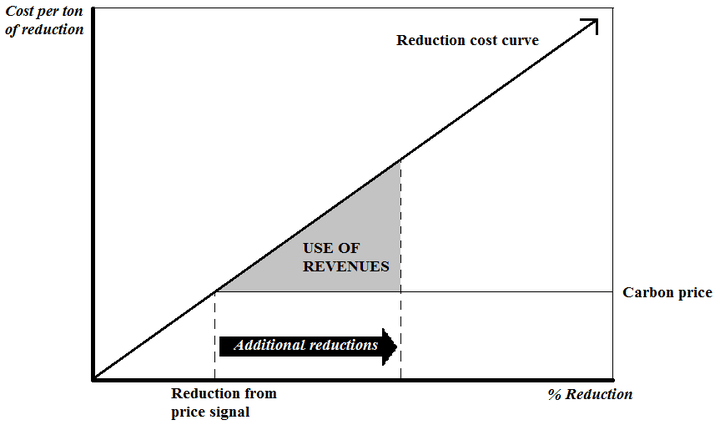
Take the long view...
The United States last week released its strategy for deep decarbonization by mid-century. While this strategy seems rather unrealistic in light of the election of climate-denying Donald Trump and the domination of Congress by climate-denying Republicans, atmospheric chemistry does not particularly care about our politics or our elections. In the United States and around the world, we have to get onto a serious emissions reduction trajectory in pretty short order if we want to avoid the worst impacts of climate change. So it is worth examining how we actually get to deep decarbonization.
Short-Term Efforts Could Hit a Dead-End
Those who have studied pathways to deep decarbonization have emphasized that, without a long-term, transformational strategy, short-term reductions could lock in technologies and infrastructure that hinder efforts to achieve a long-term deep decarbonization trajectory. For instance, a 2015 report from Energy and Environmental Economics (E3) and the Deep Decarbonization Pathways Project (DDPP) analyzed the policy implications of deep decarbonization in the United States. The report notes:
Policies that produce incremental improvements without facilitating transformation can result in technology lock-in and infrastructure build-outs that are dead ends from the standpoint of long-term emission reductions, meaning that economy-wide emissions decline for a period, but then reach a plateau beyond which further emission reductions don’t occur or are difficult to achieve without early retirement. … Some examples of potential dead-ends include a focus on building energy efficiency without end-use electrification, improvement in internal combustion engine (ICE) economy without widespread deployment of electric or fuel cell LDVs, and a coal to conventional natural gas transition in electric generation without the necessary build-out of renewable, nuclear, or CCS generation.
This is not to say that those short-term efforts are not worth investing in, to provide emission reductions now. Rather, the key is not to invest in reduction pathways in ways that lock in those technologies and their associated infrastructure.
The U.S. mid-century strategy generally follows this approach. It highlights three major categories of action: transitioning to a low-carbon energy system; sequestering carbon through forests, soils, and carbon dioxide (CO2) removal technologies; and reducing non-CO2 emissions from fossil fuel production, agriculture, waste, and refrigerants. That first category includes energy efficiency, renewables, nuclear, and carbon capture, utilization, and storage (CCUS), as well as shifting to clean electricity and low-carbon fuels in transportation, buildings, and industry.
The Role of Carbon Pricing (& Carbon Price Revenues)
The U.S. strategy notes the need for rapidly scaling investment in low-carbon technological innovation and for implementing decarbonization policies to drive technological deployment. Among a suite of policies, the strategy highlights a carbon price that starts at $20 per metric ton in 2017 and increases steadily over time, which it says could, when combined with successful innovation policies, put energy emissions on a deep decarbonization pathway.
As I’ve noted previously, using carbon price revenue to subsidize reductions beyond what a carbon tax (or cap) alone would achieve, and doing so in a cost-effective way, could massively increase the scale and rate of emission reductions. In its most basic form, a cost-effective price-and-subsidize system would involve establishing a carbon tax (or auctioning allowances in a cap), putting the revenue into a fund, and holding a reverse auction that offers subsidies (equal to the difference between the cost of the reduction and the carbon price) to any emitter that wants to submit a bid for achieving reductions, until the funds are fully committed. The subsidies would go first to the cheapest reductions beyond the price signal, working our way up the reduction cost curve (the marginal abatement cost curve) until all of the carbon price revenues have been spent, as shown in the figure below.

The Deep Decarbonization report, however, warns against an approach that relies too heavily on marginal abatement cost curves. It notes:
[T]he low-carbon replacements for many long-lived items – for example, electric industrial boilers – fall high on a marginal abatement cost curve based on current energy costs and electricity emissions intensities. “Working up the supply curve” based on a forward looking perspective could lead to emission reduction dead ends.
The report further notes that:
Carbon prices are consistent with a “low-hanging fruit” policy that procures carbon reductions sequentially on the basis of marginal abatement cost (MAC). However, deep decarbonization requires systemic changes in which measures with high apparent MACs must occur in tandem with those with lower MACs.
And it goes on to point out the flaws in MACs in general, including that:
[D]eep decarbonization requires transformations in which multiple physical elements must change in tandem to achieve emissions goals. Some of these changes will have MACs – however ambiguous – that are quite different from each other. MAC based procurement, even if it were meaningfully defined – could well cause essential components to either be delayed or omitted. … These curves had an instructional value at a certain stage in the policy discussion, but they serve as a poor guide to practical energy-system decision making.
Under this line of thinking, using nothing more than carbon prices and carbon price revenues to go after the next-cheapest reductions could doom us to falling short of the levels of decarbonization needed.
So where does that leave carbon pricing and use of carbon price revenues?
Carbon prices clearly play a role in spurring reductions, but no one should be seriously promoting the idea of using carbon prices in isolation. They have their uses, but lots of other policies will be needed. The U.S. mid-century strategy clearly notes the need for complementary policies and investments in technological innovation.
In addition, achieving deep decarbonization will probably require a range of other investments and incentives that could be funded with carbon price revenues. Some could go to RD&D with an eye on longer-term needs, while some could be cost-effectively used to subsidize additional reductions in the near term, as depicted in the chart above. Constraints may need to be put on the reverse auction, though, to ensure that subsidized reductions do not lock in technologies or infrastructure incompatible with deep decarbonization, even if that reduces the number of additional reductions that can be achieved in the near term.
The Bummer that is Political Reality
Of course, the chances of getting a carbon pricing policy under a Trump Administration and a Republican Congress are approximately, give or take, zero. For now, progress towards deep decarbonization in the United States will probably have to come from the private sector, cities, and states – and progress globally will require stronger action and leadership from other countries. We will need any of those entities with the power to put a price on carbon (as part of a suite of other climate policies) to do so. They can go farther, faster by using carbon price revenues to spur innovation and achieve additional reductions – reductions that are needed now more than ever, in light of the anticipated years of climate inaction (or worse) under a climate-denying President and Congress. Using a deep decarbonization lens can help focus the attention of cities, states, and other countries on how best to use carbon price revenues – and how not to.
Dave Grossman is the Principal of Green Light Group consulting and is a Senior Advisor to the Climate Law & Policy Project.
